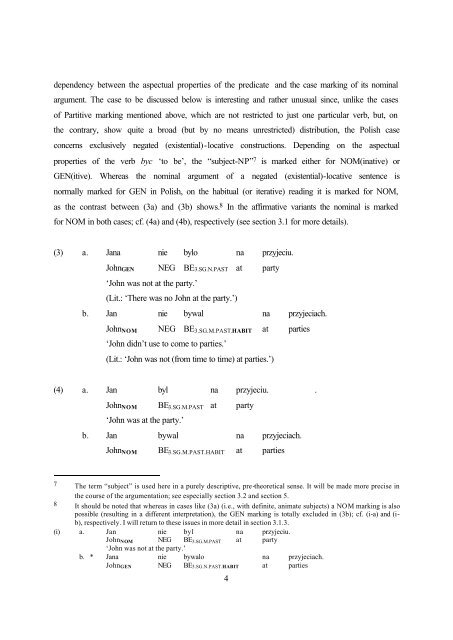Differential subject marking in Polish: The case of Genitive vs ...
Differential subject marking in Polish: The case of Genitive vs ...
Differential subject marking in Polish: The case of Genitive vs ...
You also want an ePaper? Increase the reach of your titles
YUMPU automatically turns print PDFs into web optimized ePapers that Google loves.
dependency between the aspectual properties <strong>of</strong> the predicate and the <strong>case</strong> <strong>mark<strong>in</strong>g</strong> <strong>of</strong> its nom<strong>in</strong>al<br />
argument. <strong>The</strong> <strong>case</strong> to be discussed below is <strong>in</strong>terest<strong>in</strong>g and rather unusual s<strong>in</strong>ce, unlike the <strong>case</strong>s<br />
<strong>of</strong> Partitive <strong>mark<strong>in</strong>g</strong> mentioned above, which are not restricted to just one particular verb, but, on<br />
the contrary, show quite a broad (but by no means unrestricted) distribution, the <strong>Polish</strong> <strong>case</strong><br />
concerns exclusively negated (existential)-locative constructions. Depend<strong>in</strong>g on the aspectual<br />
properties <strong>of</strong> the verb byc ‘to be’, the “<strong>subject</strong>-NP” 7 is marked either for NOM(<strong>in</strong>ative) or<br />
GEN(itive). Whereas the nom<strong>in</strong>al argument <strong>of</strong> a negated (existential)-locative sentence is<br />
normally marked for GEN <strong>in</strong> <strong>Polish</strong>, on the habitual (or iterative) read<strong>in</strong>g it is marked for NOM,<br />
as the contrast between (3a) and (3b) shows. 8 In the affirmative variants the nom<strong>in</strong>al is marked<br />
for NOM <strong>in</strong> both <strong>case</strong>s; cf. (4a) and (4b), respectively (see section 3.1 for more details).<br />
(3) a. Jana nie bylo na przyjeciu.<br />
JohnGEN NEG BE3.SG.N.PAST at party<br />
‘John was not at the party.’<br />
(Lit.: ‘<strong>The</strong>re was no John at the party.’)<br />
b. Jan nie bywal na przyjeciach.<br />
JohnNOM NEG BE3.SG.M.PAST.HABIT at parties<br />
‘John didn’t use to come to parties.’<br />
(Lit.: ‘John was not (from time to time) at parties.’)<br />
(4) a. Jan byl na przyjeciu. .<br />
JohnNOM BE3.SG.M.PAST at party<br />
‘John was at the party.’<br />
b. Jan bywal na przyjeciach.<br />
JohnNOM BE3.SG.M.PAST.HABIT at parties<br />
7 <strong>The</strong> term “<strong>subject</strong>” is used here <strong>in</strong> a purely descriptive, pre-theoretical sense. It will be made more precise <strong>in</strong><br />
the course <strong>of</strong> the argumentation; see especially section 3.2 and section 5.<br />
8 It should be noted that whereas <strong>in</strong> <strong>case</strong>s like (3a) (i.e., with def<strong>in</strong>ite, animate <strong>subject</strong>s) a NOM <strong>mark<strong>in</strong>g</strong> is also<br />
possible (result<strong>in</strong>g <strong>in</strong> a different <strong>in</strong>terpretation), the GEN <strong>mark<strong>in</strong>g</strong> is totally excluded <strong>in</strong> (3b); cf. (i-a) and (ib),<br />
respectively. I will return to these issues <strong>in</strong> more detail <strong>in</strong> section 3.1.3.<br />
(i) a. Jan nie byl na przyjeciu.<br />
JohnNOM NEG BE3.SG.M.PAST at party<br />
‘John was not at the party.’<br />
b. * Jana nie bywalo na przyjeciach.<br />
JohnGEN NEG BE3.SG.N.PAST.HABIT at parties<br />
4

















